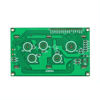OEM Through Hole PCB Assembly- Leadsintec
Name: OEM Through Hole PCB Assembly- Leadsintec
Number of Layers: 1 Layer-12layer
Origin: China
Certified: UL, CE, RoHS
Copper Thickness: 2 OZ, 1/2OZ 1OZ 2OZ 3OZ
Surface Finishing: HASL Immersion Gold OSP
Board Thickness: 0.2mm-4mm
Solder mask color: White. Black. Yellow. Green. Red. Blue
Introduction to OEM through Hole PCB Assembly:
- The procedure of assigning electronic components to a PCB using through-hole technology is referred to as through-hole PCB assembly. With through-hole technology, electrical connections are made by slipping the leads of electronic constituents through holes on the PCB and fusing them on the further side.
- Hole Printed circuit boards may be made efficiently and affordably using OEM through hole PCB assembly. Better performance, better dependability, and cost savings are just a few advantages. Additionally, it requires less effort to construct and maintain, and it may be used to a variety of products, including both industrial and consumer electronics.
- It includes placing components on printed circuit boards and soldering those components into position. The dependability and performance of the completed product are ensured via the usage of this technique. Leads that are soldered on the other side are used to mechanically attach through hole components to the PCB. This offers strong mechanical connections that are appropriate for settings requiring more durability or applications with greater stress levels, vibrations, or all of the above.
Why OEM Through Hole PCB Assembly is Beneficial?
In some cases, using OEM through hole PCB assembly has significant advantages. The following are some benefits of using through hole technology:
-
High-Power Applications:
When compared to their surface-mount equivalents, through-hole components have greater power and current ratings. Through hole technology is used for high-power circuits because the greater size and stronger solder connections provide improved heat dissipation and electrical conductivity.
-
Ease of Manual Assembly and Repair:
Through hole assembly is more forgiving when it comes to hand assembly and maintenance than other types of assembly. For low-volume or prototype manufacturing, the bigger component size and leads make it simpler to handle and solder manually. Additionally, if a through-hole component has to be repaired or improved, it is simple to desolder it and replace it.
-
Compatibility with Legacy Components:
Due to the extensive usage of through-hole technology over a long period of time, there is a large supply of legacy through hole components available on the market. For older or specialized equipment that might not be compatible with surface-mount components, this makes it simpler to find and replace the necessary components.
-
Better Mechanical and Electrical Stability:
Through hole components offer better mechanical and electrical stability, especially in applications that entail mechanical stress or necessitate frequent plugging and unplugging. Reduced odds of intermittent connections or failed solder joints are provided by the leads, which offer a more reliable and solid connection.
-
Design freedom:
Because through hole technology allows for the placement of components on both sides of the PCB, it enhances design freedom. This can be helpful for intricate or highly packed circuits when surface-mount technology alone makes component placement difficult.
-
Enhanced Heat Dissipation:
Through hole components may disperse heat more effectively than surface-mount components due to their greater size and exposed leads. This lowers the danger of thermal damage and boosts overall system dependability for components that produce heat while in use.






